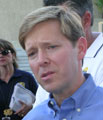 Thomas F. Armistead/ENR A Jacksonville Fire & Rescue ambulance carried the body of Willie Edwards III from the site of the collapse midafternoon Dec. 8
|
Forensic investigations will begin Dec. 10 at the construction site of the Berkman Plaza 2 parking garage in Jacksonville, Fla., following the discovery early on Dec. 8 of the body of the worker missing since the Dec. 6 collapse. Authorities declined to speculate on the cause of the collapse, but an engineer who investigated collapses at the World Trade Center, the Oklahoma City federal building and other sites suggested several possibilities.
About 2 a.m. on Dec. 8, searchers identified a location where they thought Willie Edwards III had been working at the time of the collapse. Search dogs confirmed the suspicion about 20 minutes later, said Dan Kleman, director of Jacksonville Fire and Rescue Dept. Edwards’ body was found under 20 in. of rubble, encased in 3 ft of fresh concrete. A JFRD ambulance removed the body about 3:30 p.m. in a motorcade led by the medical examiner.
The federal Occupational Safety and Health Administration will start an investigation Monday, Dec. 10, said Dwain E. Senterfitt, chief of detectives of the Jacksonville Sheriff’s Office.
Concrete subcontractor A.A. Pittman & Sons Concrete of Jacksonville began the top-level pour at 2 a.m., and about four hours later, the garage collapsed pancake-style. James D. Borders, OSHA’s Jacksonville area director, confirmed the agency was investigating whether there were any violations of OSHA regulations.
“We have no idea what happened,” Borders says.
|
Forensic engineer Gene Corley, senior vice president of CTL Group, Skokie, Ill., is not directly involved in the investigation, but he says the “possibilities range from design to contractor to someone doing something wrong at the job site at the last minute.”
One common thing that goes wrong is not having the formwork supports designed or installed correctly, Corley says. Another common cause of collapse are reshoring problems. The next most common cause is not putting the reinforcement in properly.
”Design errors occur,” Corley says. “But they are not very common, because there are lots of checks on the design. Last-minute accidents, like dropping a bucket of concrete, can happen, too, but they are not common and usually you know right away. The people who survive report it.”
Another possibility is the contractor proceeding with construction before the concrete on lower floors has gained enough strength. Corley said that seldom leads to collapse but it could.
Corley has led investigations of multiple projects, including the collapse of a parking garage under construction at Tropicana Casino and Resort Atlantic City, N.J., in 2003, and the World Trade Center twin towers in 2001.
Local media have reported a building inspector found a 26-ft-long crack during a recent inspection. Corley says the length is not as important as the width.
“If it’s a hairline crack 26 ft long, it may not mean anything,” Corley says.
Corley says the garage appears to be post-tensioned. Until the tensioning, cracks can occur. Other things that can cause cracks are misplacement of reinforcement and failure to tension in the right sequence and the possibility of a design error. But that’s least likely. Overloading with construction equipment or putting it on before post-tensioning also can lead to cracking.
“Something I have seen on other jobs is if there are large cracks, not long but wide cracks, that often is an indication of reinforcement being in the wrong place,” Corley says. “On this 26-ft-long crack, you cannot speculate if that had anything to do with [the collapse] or not.”
 Peyton
|
At the World Trade Center, Corley’s investigation lasted six months. An OSHA probe may take a year. He says other investigators will likely not be granted access until OSHA completes its report.
“It’s hard to believe from looking at this wreckage that anyone would come away alive,” said John Peyton (R), Jacksonville’s mayor, at a press conference Dec. 8. He praised JFRD for successfully rescuing 23 injured people from the site. Many of the injured workers transported to area hospitals have been released, according to William Millard Choate, president of Choate Construction Co., Atlanta, the waterfront project’s contractor.
The garage is part of a high-rise residential development by Harbor Cos., Atlanta.
 Related Links:
Related Links: 

Post a comment to this article
Report Abusive Comment